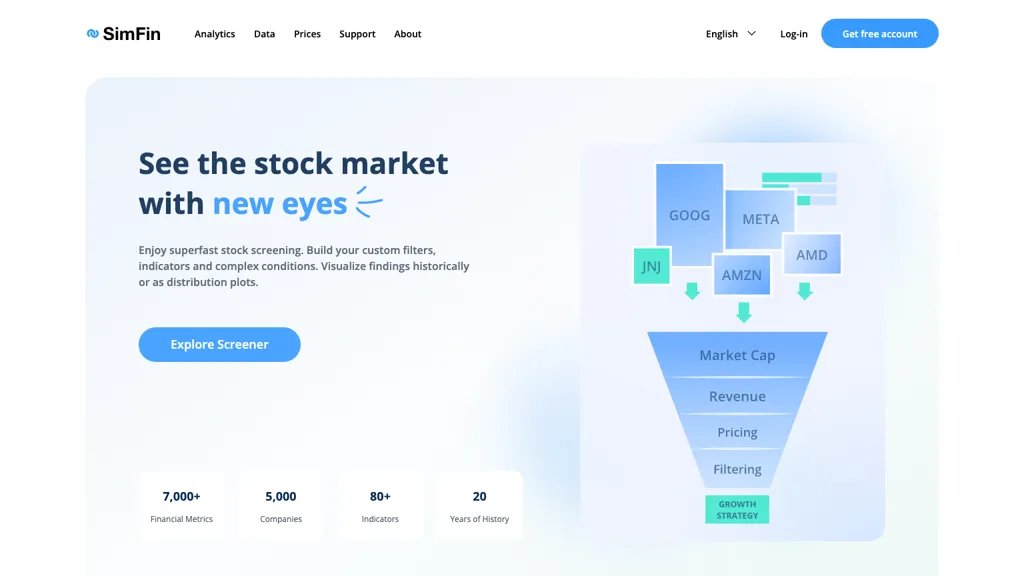It is essential to evaluate the data quality and sources utilized by AI-driven trading platforms and platforms for stock prediction to ensure accurate and reliable data. Insufficient quality data can lead to inaccurate predictions and financial losses. It could also lead to mistrust for the platform. Here are 10 top methods to assess the quality of data and source:
1. Verify the data sources
Check the origins of the data. Ensure that the platform relies on well-known, reputable sources of data (e.g. Bloomberg Reuters Morningstar or stock exchanges like NYSE, NASDAQ).
Transparency. A platform that is transparent must disclose all its data sources and ensure that they are kept up-to-date.
Avoid dependency on one source: Trustworthy platform often aggregate data across several sources to reduce bias and errors.
2. Examine the freshness of data
Real-time or. delayed data: Find out if the platform provides real-time data or delayed data. Real-time data is essential in order to facilitate trading, while delayed data can be sufficient for analysis over the long term.
Update frequency: Make sure to check the frequency at when data is being updated.
Data accuracy of historical records: Ensure that the accuracy of your historical data. free of anomalies or gaps.
3. Evaluate Data Completeness
Look for missing data.
Coverage: Ensure the platform covers a wide selection of stocks, indices, and markets pertinent to your trading strategy.
Corporate actions - Determine if the platform accounts stock splits. Dividends. mergers.
4. Accuracy of test data
Consistency of data can be assured by comparing the data of the platform to other trustworthy sources.
Error detection: Look for outliers, incorrect values or financial metrics that aren't matched.
Backtesting: Use historical data to backtest trading strategies and see whether the results are in line with the expectations.
5. Take a look at the data Granularity
The level of detail you are looking for - Make sure you can get granular details including intraday volumes, rates, bid/ask spreads as well as the order book.
Financial metrics: Make sure the platform has complete financial statements, such as the income statement, balance sheet and cash flow. Also, make sure it has key ratios such as P/E (P/B), ROE (return on equity) etc. ).
6. Make sure that you are checking for data cleaning and Preprocessing
Normalization of data: To keep consistency, ensure your platform is able to normalize all data (e.g., by adjusting dividends and splits).
Outlier handling: Check the way in which the platform handles anomalies or outliers within the data.
Data imputation is missing - Verify whether the platform is using solid methods to fill in missing data points.
7. Examine data consistency
Aligning data with the correct time zone. To prevent any discrepancies make sure that all data is synced with each other.
Format consistency: Determine if the data is presented in the same format (e.g. currency, units).
Cross-market consistency: Make sure whether data from different exchanges or markets is coordinated.
8. Relevance of Data
Relevance of data to trading strategy: Ensure that the data you collect is in line to your trading style.
Features selection: Check that the platform offers useful features to improve your the accuracy of your predictions (e.g. sentiment analysis macroeconomic indicator news information).
Examine the integrity and security of your data
Data encryption: Ensure the platform uses encryption to protect the data while it is being transmitted and stored.
Tamperproofing: Check that the data isn't altered or altered.
Conformity: Determine whether the platform meets the regulations for data protection (e.g. GDPR, GDPR or CCPA).
10. The Transparency Model of AI Platform is Tested
Explainability: The system will give insight into the way AI models employ data to generate predictions.
Find out if the system has an option to detect bias.
Performance metrics. Examine performance metrics such as accuracy, precision, and recall to assess the reliability of the system.
Bonus Tips
User feedback and reputation Review user reviews and feedback to evaluate the platform's reliability.
Trial period: Take advantage of the trial period for free or demo to test the data quality of the platform and features prior to signing.
Customer support: Ensure the platform offers robust customer support to address data-related issues.
The following tips can assist you in assessing the data sources and quality of AI stock predictions platforms. You will be able to make reliable and informed trading decisions. Take a look at the best ai investing app for site recommendations including ai stock trading, ai investment app, ai stock trading, ai trade, stock ai, incite, ai stock trading app, ai for stock trading, trading with ai, ai stock market and more.

Top 10 Tips On Risk Management Of Ai Trading Platforms That Forecast Or Analyze Stock Prices
Risk management plays an essential function in any AI-powered platform for trading stocks. It safeguards your investment by minimizing possible losses and assists you in maximizing profits. A platform that is equipped with powerful tools for managing risk can help navigate unstable markets and help you to make informed decisions. Here are 10 suggestions on how to assess the platform's risk management capabilities.
1. Evaluating Stop-Loss or Take-Profit Features
Levels that can be customized - Make sure that the platform allows you customize your stop-loss, take-profit and profit level for each trade or strategy.
Check the platform to see whether it is compatible with trailing stopped that will automatically adjust in the event that the market changes your way.
If the platform has stop-loss orders that guarantee your trade is closed at the specified price in markets that are volatile and you are assured that you will be able to trade successfully.
2. Assessment Position Sizing Tools
Fixed amount. Be sure to can define the size of your positions by the fixed dollar amount.
Percentage of your portfolio: See if you can set the size of your positions as a percentage of your portfolio total to manage risk proportionally.
Risk-reward-ratio: Determine if the platform allows users to define their own risk/reward ratios.
3. Make sure you check for support for Diversification.
Multi-asset trading: Make sure your platform can handle trading across different types of assets (e.g., stocks, ETFs, options, forex) to diversify your portfolio.
Sector allocation: Make sure the platform has tools for monitoring exposure to different sectors.
Geographic diversification. Check to see if your platform allows the trading of international markets. This will aid in spreading the risk across different geographic areas.
4. Evaluate Margin and Leverage Controls
Margin requirement: Ensure that the platform clearly outlines any margin requirements that apply to leveraged trades.
Examine the platform to determine whether it lets you limit leverage in order to lower the risk.
Margin calls: Check if the platform sends out regular notifications on margin calls to stop account liquidation.
5. Examine Risk Analytics and Reporting
Risk metrics: Make sure the platform has key risk metrics (e.g., Value at Risk (VaR), Sharpe ratio drawdown, Sharpe ratio) for your portfolio.
Scenario assessment: Find out whether you are able to simulate different scenarios of markets on the platform in order to determine potential risks.
Performance reports: Determine whether you can obtain detailed reports on performance from the platform, which include the risk-adjusted outcomes.
6. Check for Real-Time Risk Monitoring
Portfolio monitoring: Ensure the platform provides real-time tracking of your portfolio risk exposure.
Alerts and notifications. Verify whether the platform offers real-time notification of events involving risk.
Risk dashboards: Check whether the platform has customizable risk dashboards for a comprehensive view of your risk profile.
7. Test Stress Testing and backtesting
Stress testing - Make sure that your platform lets you test strategies and portfolios under extreme market situations.
Backtesting. Verify that the platform supports backtesting. This is the application of historical data to assess the risk and the performance.
Monte Carlo simulations: Verify whether the platform utilizes Monte Carlo simulations to model the possibility of outcomes and assess the risk.
8. Verify Compliance with Risk Management Regulations
Make sure that the platform is in compliance with the regulatory compliance requirements (e.g. MiFID II regulations in Europe, Reg T regulations in the U.S.).
Best execution: Verify that the platform follows the best execution practices. Trades are executed at the most affordable price possible to minimize the chance of slippage.
Transparency Examine the transparency of the platform and the clarity of the disclosure of risks.
9. Look for parameters controlled by the user.
Custom Risk Rules: Ensure that you have the ability to create custom rules for risk management (e.g. a maximum loss per day, a maximum amount of tradeable position).
Automated risk control: Check if the platform can automatically enforce risk management rules in accordance with your predefined parameters.
Manual overrides Determine whether you are able to manually override the automated risk control in the event of an emergency.
10. Review User Feedback and Case Studies
User reviews: Read feedback from users to assess the effectiveness of the platform in risk management.
Case studies: Search for cases studies or testimonials that show the platform's ability to manage risks.
Community forums - Check to see if the website has a community for users that is active, and where traders can share their strategies for managing risk.
Bonus Tips:
Trial period for free: Experience the risk management capabilities of the platform in real-world scenarios.
Support for customers: Ensure that the platform offers a solid support to any questions or issues related to managing risk.
Educational resources: Find out whether the platform has educational resources or tutorials on best practices in risk management.
With these suggestions, you can assess the ability of AI software for analyzing and predicting stocks to control the risk. This will help you pick a system that is safe for your capital, and minimizes any potential losses. It is crucial to use a robust risk management tool to be able to navigate market volatility. Read the best ai stock price prediction for more recommendations including best ai stocks to buy now, ai options trading, investing with ai, stocks ai, free ai tool for stock market india, ai investment tools, ai software stocks, ai tools for trading, ai software stocks, ai share trading and more.
